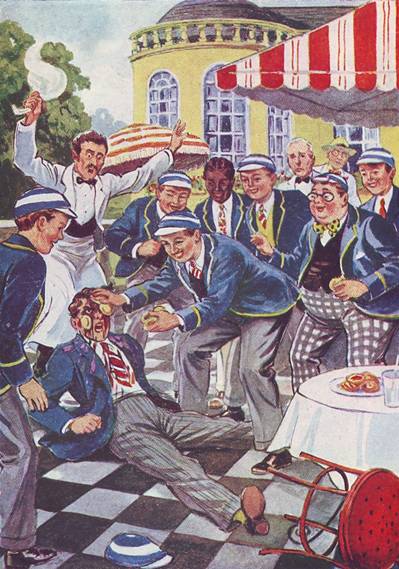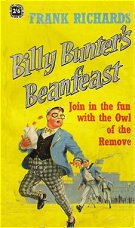
Billy Bunter's Beanfeast by Frank Richards.
Published by Cassell November 1950
Illustrated by R.J.MacDonald.

Of all the post-war Billy Bunter books, three are outstanding. “Bunter Does His Best,” “Billy Bunter Butts In,” and, this one, “Billy Bunter’s Beanfeast.
By 1952, Charles Skilton, the publisher who had come to Charles Hamilton’s rescue following WW2 had realised that he was unable to cope with the enormous success of the Bunter books, and Cassell had taken over the publishing of the Bunter books.
I have a special affection for this story. It was one of the first two Bunter books I ever owned. This was my introduction to Greyfriars & the world of Charles Hamilton. Over forty years later, I still love this book. Like many children at that time, I was a regular attendee at Sunday school. My virtue was rewarded every year by a “treat” in summer, involving a coach trip to a fun park, and by a party at Christmas. At these parties there was, apart from the ham sandwiches, fancy cakes, blanc-mange & jelly: together with a conjurer; a prize giving. For my “attendance & good conduct” over the year I was awarded Billy Bunter’s Beanfeast.
 This
is, basically, an original story. Of course, the theme had been explored before
by Frank Richards, but not – as was the case with some of the post-war book –
the plot.
This
is, basically, an original story. Of course, the theme had been explored before
by Frank Richards, but not – as was the case with some of the post-war book –
the plot.
Ironically enough, it was Bunter’s pater who was the founder of the feast – or beanfeast. As the director of a steam-ship company, he was able to obtain for his son 8 free tickets for a channel crossing to Boulogne. We learn, in this story, that annually, Greyfriars celebrated Founder’s Day, which gave all Greyfriars men a one-day holiday from classes.
Bunter chooses his 7 travelling companions with care. His father, having sent him a postal order for 5/- to “cover incidental expenses,” he needs people around him who will be prepared to stand him all the little feeds and other things essential to a day’s holiday in France. The lucky recipients are the Famous Five, plus Smithy & Redwing.
Smithy has a particular reason for accepting Bunter’s invitation. He has, he fondly imagines, a “system” for breaking the bank at the casino. By accompanying Wharton & Co on a trip to France he can allay Quelch’s suspicions.
Horace Coker has also booked tickets on the steamer, for himself & his chums.
There is the obligatory
seasickness always encountered by Bunter on a boat. There is the obligatory
comic confusion at customs. Then, the real drama begins.
It is obvious that Hamilton was writing not only about a subject he knew – gambling – but of a locality also. Local descriptions of cafés, tram rides, casinos, etc. are superb. Smithy & Reddy soon manage to “lose” Wharton & Co. With the aid of a false moustache he enters the casino! The faithful Redwing at his side.
The author – himself a gambler – was here writing, almost autobiographically, about gambling. Smithy, here is superbly drawn.
It had been nearly fifty years earlier that Herbert Vernon-Smith had first been introduced to readers of the Magnet. At the time I was unaware of this. Here, in this story, Smithy was to sink lower than he had ever sunk before. He was to become a criminal!
This story is a detailed, autobiographical account of the desperate mania that grips a compulsive gambler. It also encapsulates what Greyfriars is all about. The triumph of good over evil!
Generally speaking, Hamiltonians agree that the post-war books were never as good as the Magnet was in it’s prime. I agree. But, this is a first rate story, equal to anything published in the Magnet’s “golden age.”
Billy Bunter’s Beanfeast is superb! One of the finest Greyfriars stories ever written.